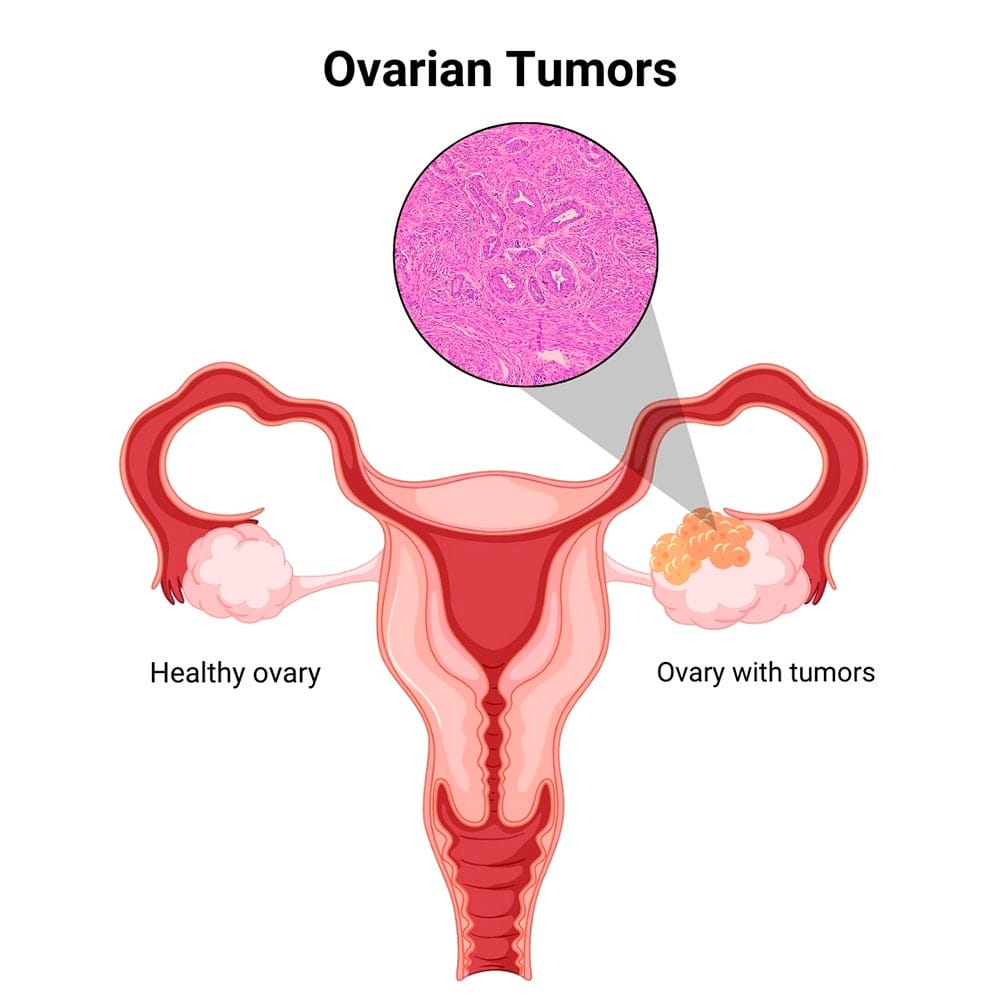What Are Ovarian Tumors?
 Ovarian tumors are abnormal tissue masses that develop in the ovaries. Ovarian tumors can be of any size and may range in severity from benign ovarian tumors to malignant tumors. The most common types include benign ovarian tumors that are non-cancerous but require treatment for symptom relief and to prevent cancer, as they may be pre-cancerous.
Ovarian tumors are abnormal tissue masses that develop in the ovaries. Ovarian tumors can be of any size and may range in severity from benign ovarian tumors to malignant tumors. The most common types include benign ovarian tumors that are non-cancerous but require treatment for symptom relief and to prevent cancer, as they may be pre-cancerous.
Malignant tumors, on the other hand, require urgent treatment. Symptoms may involve abnormal uterine bleeding, pelvic pain, bloating, and urinary problems.
These symptoms often are confused with other conditions, such as:
Early diagnosis of ovarian tumor types is crucial. When you experience abnormal symptoms, you need to rely on the expertise of an experienced gynecologist. Waiting can lead to serious consequences that include the spread of cancer cells. In Midtown NYC, find that experience at Cohen Medical Practice (CMP).
What Are the Different Types of Ovarian Tumors?
Ovarian tumor types are categorized according to the type of cell from where they originate. Each type is different and relevant to treatment decisions. Tumors may be benign, borderline or malignant. The most common non-cancerous type of ovarian tumors originating in the ovaries are ovarian cyst tumors.
Other ovarian tumor types include:
- Epithelial tumors. These arise from cells on the surface of the ovaries. These are generally benign ovarian tumors but could become malignant, similar to how endometrial polyps develop.
- Germ cell tumors. These tumors arise from the cells that produce eggs. These are usually benign but may turn out to be malignant. These also can present symptoms like amenorrhea or irregular menstruation.
- Sex cord-stromal tumors. These develop from the ovarian tissue responsible for the production of hormones; an origin that also results in hormonal imbalances, such as polycystic ovarian syndrome.
Identifying the specific type of ovarian tumor allows for targeted treatment, which can range from observation to surgery, depending on the severity.
What Causes Ovarian Tumors and How Are They Diagnosed?
The causes of ovarian tumors are not so well known, but they can come with many risk factors. Most of the risk factors show some overlapping with other gynecological conditions like ovarian fibroid tumors, salpingitis and even ectopic pregnancy. The development of an ovarian tumor is highly influenced by hormonal factors and genetic predisposition, as with other related conditions like ovarian fibroid tumors and endometriosis.
Common causes include:
- A family history of ovarian, breast or colon cancer can increase your risk.
- BRCA1 and BRCA2 genetic mutations predispose women to both ovarian and breast cancer.
- Hormone replacement therapy or long-term use of medications that enhance fertility may further increase the risk.
- Age plays a major role, with risks being higher in women over 50 years or in those who are post-menopausal.
The outcome of the malignancies of the female reproductive system can be optimized by early detection and focused treatment. Ovarian tumors usually present themselves through physical examination, imaging and blood tests. These procedures confirm whether the tumor is benign or malignant and rule out other conditions.
The diagnostic process includes:
- Pelvic examination that involves a medical examination for any abnormalities in the ovaries and uterus
- Ultrasound and sonogram, which produces clear images to detect cysts, fibroids and other tumors
- Blood tests for detection of ovarian cancer
- Laparoscopy, a minimally invasive technique for suspected endometriosis and pelvic inflammatory disease
The sooner a problem is identified, the sooner treatment with greater hope of success can begin. If a tumor is detected, additional testing determines if it’s benign or malignant and what course of therapy should next be followed.
What Can I Expect Before, During and After Treatment?
The treatment of ovarian tumors involves a detailed appraisal in terms of both blood tests and imaging for the optimization of the most appropriate treatment. Recovery hinges largely on whether surgery or any other form of treatment is required and how complicated the tumor extraction would be.
The process includes:
- Preoperative evaluation, with imaging, a complete assessment and blood tests
- Surgery, involving a minimally invasive procedure that usually takes one to three hours
- Cancer treatment that may be required in the form of chemotherapy or radiation to improve your chances of complete remission
- Post-operative course of rehabilitation that lasts about four to six weeks with limited activity
- Pain management, which consist of a limited time on prescription pain medication, followed by relief from over-the-counter pain relievers
The surgical risks, such as infections or bleeding, are small when you rely on Dr. Felix Cohen. Contact Cohen Medical Practice (CMP) now to check out your symptoms and learn about treatment options. At this Midtown practice, you can get every type of gynecological service from routine check-ups to fertility services and menopause care.

